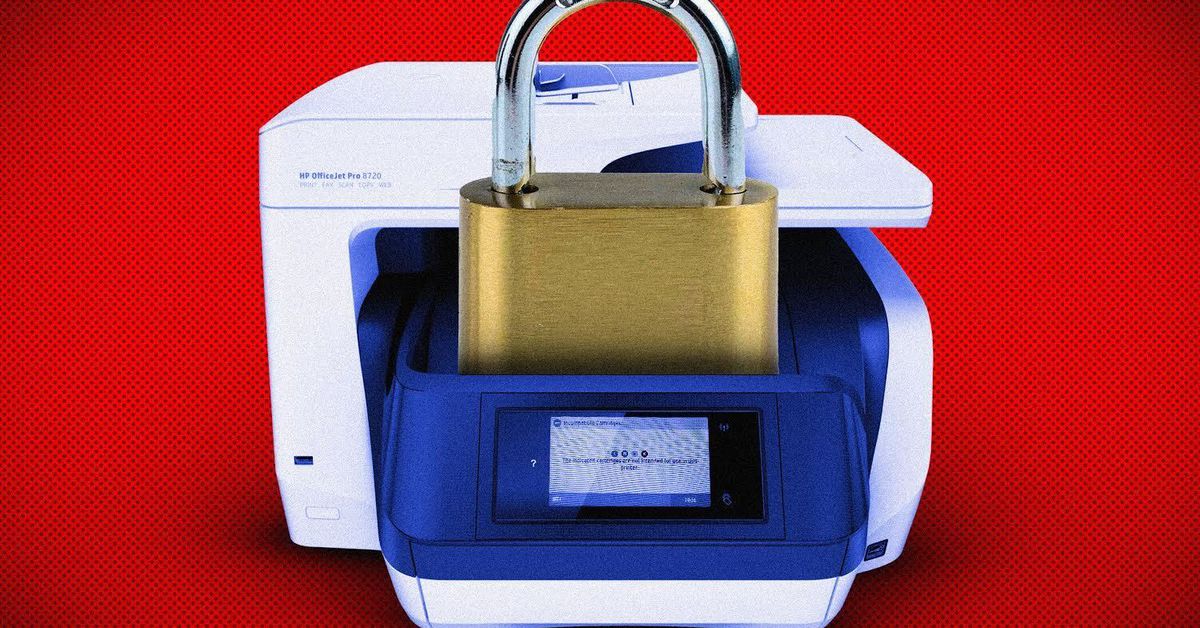
A couple of weeks ago, Nilay wrote about the Brother laser printer everyone else has. It’s cheap, reliable, and the toner lasts a long time. Get a Brother laser printer, he said, and basically never think about your printer again. You know what part of Nilay’s post sounded really nice? This part right here:
It has been connected to our Wi-Fi for like six years straight, and I have never replaced the toner. It prints Amazon return labels from my phone without complaining, and it does not feel like the CEO of Inkjet Supply and Hostage Situations Incorporated is waiting to mug me or enable DRM at the slightest provocation.
I, on the other hand, spent a couple dozen hours between September 2021 and February 2022 trying to defeat the region lock on my HP printer so I could go back to not thinking about it.
Hey, did you know most inkjet printers are region-locked?
Let me back up. In 2019, I was living in the Netherlands. I needed a printer, so I paid 192 euros (about $213 at the time) for an HP OfficeJet Pro 8720 — the Wirecutter pick for all-in-one printers at the time, shoutouts to my old crew. The Wirecutter article (which I probably edited when I worked there) even warned that a laser printer would be less trouble. Liam McCabe’s cri de cœur about printers was fresh in my mind. And yet, I went for the inkjet all-in-one anyway.
It was fine at first. Aside from being too big to fit on my office cabinet, it did everything I needed it to do. It had a flatbed scanner and a sheet-fed scanner that could scan both sides of a document. It had 2.4GHz Wi-Fi and an ethernet port, and an insecure secure web interface. It had Google Cloud Print (until that stopped working the next year). It had AirPrint. It also had two separate scanner apps, one of which could save OCR’d PDFs, which was very handy before everyone built that into their operating systems. It had a Windows app, the main function of which seemed to be to try to sell me an ink subscription. It could print in color. It could print on both sides of the page. It could print photos, though not like amazing ones. It was fine.
In April 2020, I paid 85 euros (about $93) for replacement ink cartridges. Now, for most of that time, I was not printing a lot of stuff. I was using the scanner a bunch and, especially after the schools closed down because of covid, I printed a lot of coloring sheets and activity pages for my kids. Paying that much for ink so soon after buying the damn thing wasn’t great. In retrospect: lol.
The next summer, my family moved back to the US somewhat earlier than intended. We had some extra room in our flat-rate shipping container, so rather than sell the printer and buy a new one in the US, or fill the empty space with vintage Gispen chairs or hagelslag or something useful, I brought the printer. Waste not, want not! I swapped the power cable for a US one, and away we went.
In retrospect: lol
It was fine until my yellow ink cartridge (allegedly) ran out, and the printer stopped printing in color. I soldiered on with the black cartridge. Until one day I tried to print a return label (in black and white!) and the printer decided it wouldn’t. Not until I replaced the yellow ink cartridge. Fine. I paid 207 goddamn dollars for replacement cartridges, put them in, and discovered that HP region-locks its printers.
If you need a refresher: region-locking is a form of DRM mostly used by media and software publishers so they can sell the same content at different prices in different regions. If you buy a DVD in Europe, you need a DVD player that can play Region 2 discs.
DVDs and Blu-rays are region-locked. (CDs aren’t, which is probably why DVDs are.) Game consoles used to be. Streaming media is region-locked. Software is often region-locked. Kindle books are region-locked unless the publisher requests otherwise. But outside of, like, entertainment devices, it’s rare for hardware to be region-locked. Except, as it turns out, printer cartridges.
The genuine HP ink cartridges, for which I paid as much as I paid for the actual printer, would not work with the printer they were designed to work with because I bought it in a different part of the world. It wasn’t even a cheaper part of the world unless we’re talking healthcare or midcentury furniture.
Now, I realize this is an edge case. Most people don’t move across the world and bring a printer with them. But region-locking is only one of many ways printer companies use DRM to squeeze money out of their customers, and if you have an inkjet printer you might have already run into one of them. Blocking third-party ink cartridges, preventing people from refilling their cartridges, and remotely bricking working printers if they reach “end of life” or if you cancel your ink subscription? Just a day’s work for Inkjet Supply and Hostage Situations Incorporated.
Anyway. Having just paid two hundred bucks for new ink cartridges for a perfectly functional printer that I had already hauled halfway around the world, I was determined to get the printer and the cartridges working together. (This is known as the sunk cost fallacy.)
And I did get them working — after spending dozens of hours over five months. Here’s how it went down, as reconstructed from a tweet thread, some hastily jotted notes, a few screenshots, and some emails. (Names have been changed, except for Ferdinand and John, who were patient and helpful respectively.)

